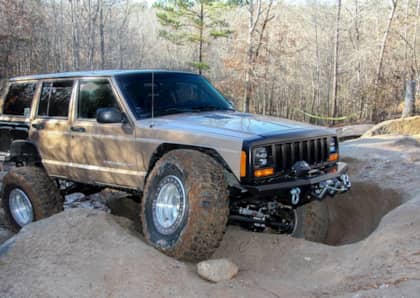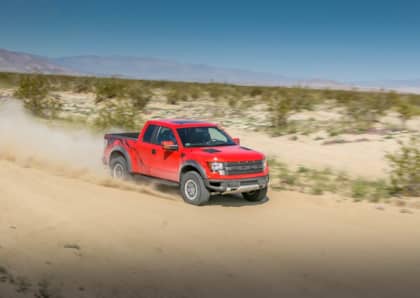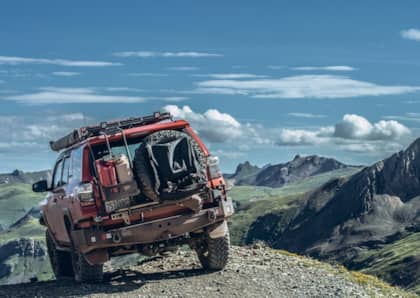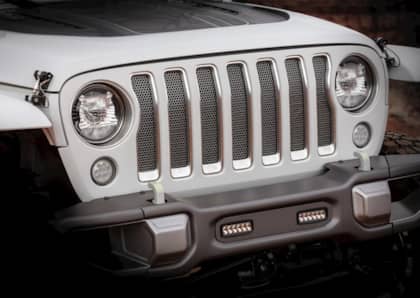The 6 Best 4x4 SUVs That Aren't a Jeep Wrangler
We live in a world of the Jeep Wrangler Unlimited JK. Just 10 years ago, though, it was the TJ Wrangler. The open-top Jeep has been popular for a reason: It's just plain capable. And because the stock Wrangler is so capable, the aftermarket has always been quick to supply components to build them into extreme off-road dominators. The Wrangler has not seen any real, direct competition in years; but with the Ford Bronco coming back, it's sparked thoughts of all the vehicles that could at least partially knock the crown off the Wrangler.
As a baseline, we decided to look at SUVs from the '90s to present. Random people were polled, opinions weighed and tallied, and a list was compiled. Here are the six most frequently mentioned in our exploration:
1. Ford Bronco (Fullsize)

The last gen fullsize Ford Bronco was a popular choice. Built with a twin-traction beams frontend, these rigs were considered the most capable IFS rigs in the list. It was the only fullsize vehicle to come up in poll answers and was one of two that had a (partially) removable top like a Wrangler.
Available with a healthy 5.0L V8 engine, the Bronco can be used for high-speed desert runs as well as torturous rockcrawling. Thousands of them were built before its ultimate demise. Plus, they can usually be picked up on a budget.
2. Jeep Cherokee

The Wrangler is obviously not the only Jeep brand vehicle that's capable. Long before the Unlimited JK came along with its four doors, the XJ Cherokee was the vehicle of choice when more space was needed than a TJ Wrangler could accommodate.
The XJ Cherokee was built by the millions. Offered with the virtually indestructible 4.0L, Unitbody, and solid front and rear axles, it's a great builders choice. The aftermarket support waned for several years, but it's finally catching up to the popularity of the rigs. Think of them as a budget JKU; you just might need to grab the sawzall if you really want an open top.
3. Jeep Grand Cherokee

The Grand Cherokee has always been one of Jeep’s premium vehicles. All the bells and whistles, including V8 options and a straight front axle, allow the Grand Cherokee to be a luxury wheeler. The ZJ Grand Cherokee ('93 to '98) has the best aftermarket support, with the WJ ('99 to '04) close behind.
When the WJ ended its run, the straight axle gave way to an IFS system, and the Grand subsequently fell out of favor for most enthusiasts that wanted to make big modifications.
(Are you Team IFS or Team Straight Axle?)
4. Suzuki Samurai

The little Japanese vehicle is the most direct competition for the Wrangler in the entire list, and removable top and straight axles front and rear are the reason why. The '90s Samurais stepped up to a fuel injection system, though the little 1.3L inline four cylinder still was no powerhouse. Luckily, the little rigs are light.
Aftermarket support for Samurais has been a roller coaster over the years. A few companies have continued their strong involvement, while others have come and gone. Being a small leaf sprung vehicle, the Samurai is not far off from an old flatfender Jeep, the Wrangler’s grandfather. Purchase prices remain comparatively low and can be a great budget alternative to a Wrangler if you don’t mind the small size.
5. Toyota FJ Cruiser

The newest of the vehicles that came up in the poll repeatedly is the FJ Cruiser. The capable Toyota is generally a favorite of those who have an aversion to Jeeps for one reason or another.
The lack of four real doors hinders it only slightly; the rear half doors open up the vehicle quite a bit, and the back seat is bigger than all the non-four door Wranglers. The later production years of the FJ Cruiser were a struggle, however, and the vehicle ultimately died for new model years. Aftermarket support has remained steady at a much lower scale than the Wrangler, though plenty of performance components are consistently available.
6. Toyota 4Runner

The 4Runner has been built for many years and has been a direct competitor for the Jeep Cherokee since the Cherokee came into being. Early years saw a straight axle, but by the time the '90s came around, the vehicles had switched over to an IFS system.
Aftermarket support has always been a struggle for the 4Runner. A continually growing option is to ditch the IFS system and set up a straight axle on leaf springs or links. As the 4Runner changed through the model years, the vehicle became more of a luxury wheeler than a dedicated off-roader. The IFS is a bit of a deterrent in late-models, but there are still great parts on the market to gain the extra performance.
More From Driving Line
- Next, check out five more of the best 4x4s out there.











